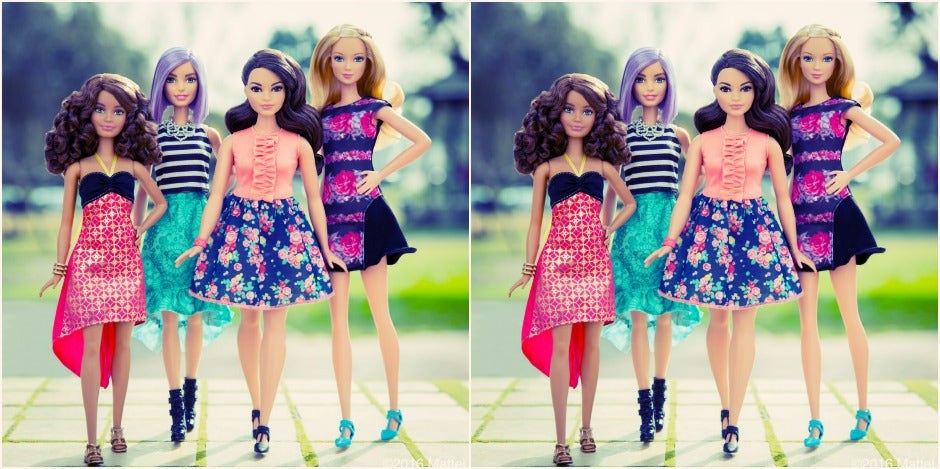Let's Kill Barbie Altogether: Why The Barbie Body Revamp Won't Help
Women shouldn't be placed into figurative cardboard boxes.
 Barbie.com
Barbie.com Mattel is introducing a new line of Barbie meant to soothe over all us angry feminists. Now, she'll come in Original, Petite, Tall, and Curvy versions.
So why am I not jumping for joy that a major toy company is giving in to countless years of negative feedback from mothers complaining about lack of diversity? Maybe I'm just feeling negative, but Mattel — it's too little, too late.
I feel like someone is just sticking a big old pacifier in my mouth and telling me, "Suck on that, baby!" Mattel's sales have plummeted because girls would rather play with edgier dolls.
My daughter is eleven and has a huge bin full of her "diverse" Barbies. You know, ones with differently colored hair. She's much more interested in Monster High dolls now. Maybe it's the tween in her yearning to break out of the "perfect" Barbie world shining through, but I don't think so.
My influence over her has sunk in.
I still remember the moment in the bathroom when as a toddler she held out a naked Barbie to me and in her halting words asked, "Why do all the Barbies' breasts look like this? They're so ... pointy."
"Most women don't look like that, huh?"
"No! It's weird," she said as she went about playing.
We've continued that conversation throughout the years and talked about what women's bodies look like and the ideals we see represented.
Over the past few years, she's gravitated more to the Bratz and Monster High genre of doll more than Barbie and she's said it's because those dolls are more interesting and creative-looking.
Barbie is becoming a dinosaur. No matter if Mattel makes her slightly more-rounded or height-challenged or "blessed", she's still going to look the same: Generic. A "woman" for little girls to dream themselves into. A plastic stand-in for what women can be.
Don't get me wrong, I know girls are going to play with dolls and I'm not saying that's a bad thing. Make-believe is awesome. Bratz and Monster High creations are just as plastic as Barbie, but at least they don't pigeonhole diversity into neat categories.
These days, girls can imagine themselves into exotic creatures with outlandish traits like snakeskin, webbed hands and feet, or cat ears bursting from their heads.
Their naked bodies are oddly-shaped and proportioned, removing any need for a girl to imagine herself into that body type. Instead, she can just let her imagination run wild and free into strange and exhilarating new possibilities.
The time for Barbie has come and gone. Let her die a quiet death, much like the Beanie Babies when their uniqueness and fun had grown stale. (Yes, yes, I know they've been revamped with big eyes and called Beanie Boos, but that's beside the point.)
Do I think dolls modeled on realistic humans should still be made? Yes, there's an audience for those kinds of dolls. But these neat "diverse" Barbie categories aren't bold enough.
If they're going to model new dolls to promote healthier body image in girls, then let's get real.
Mattel's "Curvy" doll is still an idealized female stereotype. Women in the world who look like "Curvy" Barbie are your plus-size models of the world. They're curvy in all the right places, but they still fit a certain accepted pleasing female aesthetic.
If we're going to make a doll that's realistic, let's give her some cellulite, flabby upper arms and stretch marks. Let's stop pretending that we're being diverse when we open the door the tiniest crack. Let's fling that baby wide open and say, Hey! THIS is what diverse looks like!
Women are skinny, curvy, chubby, plump, fat and everything in-between. We aren't white or black — we're every shade imaginable. We can't be categorized neatly. We don't want to be placed into figurative cardboard boxes.
Let's kill Barbie and every look-alike idealized woman doll and replace her with diverse, unique and thrilling options: dolls with glasses, braces, disabilities, short hair, blue hair, flat chests, round hips, and on and on.
The only way we're going to change the world for our girls and boys is to embrace reality in all its diverse manifestations, and represent that actuality loudly as role models, both human and plastic.
More content from YourTango:
